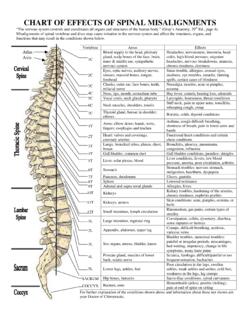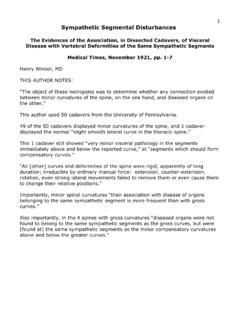Transcription of The Origins Of The Grostic Procedure - Up C Spine
1 The Origins Of The Grostic Procedure By John D. Grostic , , International Review of Chiropractic - March 1978 (pages 33-35) About the Author: John D. Grostic , , , is a 1969 graduate of Palmer College of Chiropractic and was active in Grostic Chiropractic Presentations, Inc., from 1968 to 1976. The son of John F. Grostic , , and Grace G. (Johnson) Grostic , the author has a long list of educational and research credits. He has been a guest lecturer and extension faculty member of Palmer College of Chiropractic. As of 1977, he became a full-time faculty member at Palmer and is involved in a computer-assisted x-ray analysis research project there.
2 He has conducted extensive research into the Grostic Technique and x-ray safety and radiation hazards. Dr. Grostic has been a member of ICA since his graduation from Palmer and in 1975; he was elected a Distinguished Fellow of the ICA. He was chairman of the Research Committee of the Michigan Chiropractic Council from 1971-73. He maintained a private practice in Ann Arbor, MI, from 1969 until his move to Davenport in 1977. HISTORY: The Grostic Procedure had its Origins in the Palmer Specific Upper Cervical technique. It was one of several techniques that developed as a result of efforts to standardize chiropractic procedures and methods. Much of this effort to standardize the profession was the result of a group of chiropractors under the direction of Dr.
3 B. J. Palmer. The group, known as the Palmer Standardized Chiropractic Council, founded by Roy G. Labachotte, , provided a forum at which research and new ideas could be presented and exchanged. Dr. John F. Grostic was one of the members of this organization. He, along with other chiropractors, would present research and ideas at the annual meeting of the Council. This annual meeting evolved into the Pre-Iyceum program where it continued to be the forum at which new ideas could be presented. At these forums and in the "Bulletin" published monthly by the Council, Dr. Grostic presented much of his research work. Since much of the material was being presented as it was being developed, the continuity in the presentations was lacking.
4 Because of this, several chiropractors requested that Dr. Grostic assemble his research into a "package" that could then be presented to them at one time. In 1946, Dr. Grostic presented the first seminar of the research work to a group of 14 doctors. At the present time, the Grostic Procedure is being taught at Palmer College of Chiropractic as an elective course for senior students and it also is being offered to practicing chiropractors through Palmer College Postgraduate Education Seminars. The Grostic Procedure is primarily a measurement system. The x-ray analysis is the real core of the Procedure and is the one area that has remained constant over the last 30 years. During that time, the adjusting methods have changed several times in an effort to improve the effectiveness of the Procedure .
5 Since 1946, the adjustment has changed from a Palmer Toggle to what may still resemble a "Toggle," but which is now a much shorter and lighter thrust. The contact point, the pisiform, usually travels less than one-fourth inch during the thrust. The result of this shortened thrust has been twofold. First, discomfort for the patient has for the most part been eliminated. Second, and more important, the atlas misalignment can be reduced more consistently and predictably. The Grostic Procedure originated as a means of precisely measuring the misalignments of the atlas and axis and this is still its prime function. It provides a means of evaluating various adjusting procedures . Because of this evaluating ability, new adjusting methods are continually being tested.
6 When a particular change is proven to reduce misalignments better, it is incorporated into the adjusting aspect of the Grostic Procedure . The Procedure begins with the most basic chiropractic philosophy -- that the human body has an inborn intelligence that controls function, growth and repair, and that this inborn intelligence must maintain a balanced and stable relationship between the body and its internal as well as its external environment. It is the function of the nervous system to maintain this homeostasis. To maintain this critical balance effectively, the nervous system must be continually informed not only of any changes in the external environment, but also of the current state of all internal systems.
7 To accomplish this task, large amounts of data must be continually transmitted over the nerves to the brain where this information is integrated and acted upon. If a response is required, it is transmitted over nerves to the appropriate structure, organ or cells. Any interference with the transmission of data or of the response can upset the delicate balance of homeostasis. The Grostic Procedure attempts to correct or reduce misalignments that have produced subluxations and their resulting nerve interference. The reduction of these subluxations allows the data and the response to again travel between the body and the central nervous system re-establishing homeostasis.
8 This Procedure provides a precise means of evaluating a misalignment of the upper cervical region of the Spine . The misalignment can be a lateral or rotational misalignment of the atlas with respect to the skull or with respect to the axis or any combination of these misalignments. Of course, a misalignment does not always produce a subluxation and the presence of a subluxation must be determined by clinical evaluation of the patients. But, if misalignments are said to produce subluxations; one should be able to cite the mechanism by which this occurs. Based on current knowledge, it would appear that there are at least four major mechanisms by which a misalignment of the upper cervical area of the Spine can produce nerve interference and possible nerve dysfunction: 1.
9 Because of trauma to the upper cervical area, "splinting" by the cervical muscles occurs to immobilize the area. This "splinting" can produce direct mechanical irritation to the nerves passing through these muscles, especially those that make up the brachial plexus. 2. Edema in the tissues surrounding the vertebrae can produce direct mechanical irritation to the nerves, arteries, and veins passing through the intervertebral foramen and also to the superior cervical ganglia. 3. Extreme rotatory subluxations have been shown to reduce or occlude the vertebral arteries, thus reducing blood flow to the brain and to the upper cervical cord. Rotatory subluxations between atlas and axis also cause the cervical cord and medulla to be displaced laterally away from the direction of rotation.
10 This allows the tip of the dens to compress the medulla. (1). 4. Direct traction on the cord can be produced by the denticulate ligaments. This mechanism is the same mechanism that has been postulated as an explanation of the loss of lower extremity function in median herniation of the cervical discs (2). This traction on the spinal cord interferes with the normal function of the nerve tracts by at least two probable means: (a) Direct mechanical irritation of the nerves of the spinal cord. (b) Closing the small veins of the spinal cord, producing a stasis of blood in the cord (3) with a loss of nutrients necessary to carry on the very high energy reactions necessary for nerve conduction. The Grostic Procedure did not dictate the "normal position" of the atlas.

